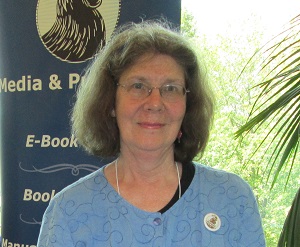 Relevant History welcomes Janet Oakley, historian and award winning author of historical fiction. Her book Tree Soldier won the 2012 EPIC ebook award for historical fiction and the 2013 grand prize for Chanticleer Books Reviews. Another long work, The Jossing Affair, won first place in historical fiction Chanticleer Books Reviews. Janet has essays in the “Cup of Comfort” series, writings in the Clover Literary Rag, and historical articles on Washington State history. Timber Rose is the prequel to Tree Soldier. When she’s not writing, Oakley can be seen wearing petticoats and teaching 19th-century life, hands-on, to kids. To learn more, check out Janet’s blog and follow her on Twitter and Facebook.
Relevant History welcomes Janet Oakley, historian and award winning author of historical fiction. Her book Tree Soldier won the 2012 EPIC ebook award for historical fiction and the 2013 grand prize for Chanticleer Books Reviews. Another long work, The Jossing Affair, won first place in historical fiction Chanticleer Books Reviews. Janet has essays in the “Cup of Comfort” series, writings in the Clover Literary Rag, and historical articles on Washington State history. Timber Rose is the prequel to Tree Soldier. When she’s not writing, Oakley can be seen wearing petticoats and teaching 19th-century life, hands-on, to kids. To learn more, check out Janet’s blog and follow her on Twitter and Facebook.
*****
I have always loved to camp and tramp. From a very early age, I went tent camping with my family all over the Northeast and eventually the West. It was always a magical time (admittedly, miserable if it rained too much), for to be in nature was for me instructional and energizing.
I never thought much of how these places came to be until I was an adult. When I needed a paper for a university class, I began to pay attention to the stories my mom told me of the Civilian Conservation Corps (CCC) in Idaho where she grew up. The CCC made trails, planted trees, and built cabins, ranger stations, and fire look-outs back in the 1930s. My historical novel Tree Soldier, about a CCC camp in the North Cascades of Washington State, came out of my research. Its prequel, Timber Rose, explores the work of earlier, pioneering people who built an appreciation for the wilderness and the need to preserve it.
The Pacific NW and the Birth of Hiking Clubs
The North Cascades, the setting for Timber Rose, is a beautiful, rugged area in the north of Washington State. Until 1889, the state was a territory. Formed in 1852, it was one of longest held territories seeking statehood. Though it became a state, Washington had over 2.25 million acres in the federally held Pacific Forest Reserves. In 1897, the Forest Bureau was created by an act of Congress, with Gifford Pinchot as head. Eight years later (1905) 63 million acres of forest nationwide was transferred from the Interior Department to the Agriculture Department. At the same time, the modern Forest Service was created. The Pacific Forest Reserves on the east side of Puget Sound became the Washington National Forest.
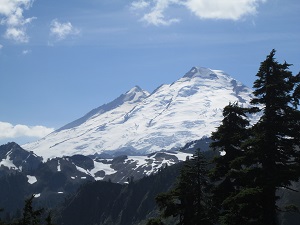 Against this dry history, inspired by the writings of John Muir and other nature writers, some amazing things happened. In 1890, a group of climbers, which included 21-year-old Fay Fuller wearing blue flannel bloomers and a boy’s boots with caulks, climbed Mount Rainier. The following year a group of climbers made it to the top of Mount Baker (Mount Kulshan in my novels) in the North Cascades. In the next couple of years, wilderness enthusiasts organized. In 1894, on the summit of Mount Hood, Oregon, the Mazamas was formed. Of its 105 members, a good portion were women.
Against this dry history, inspired by the writings of John Muir and other nature writers, some amazing things happened. In 1890, a group of climbers, which included 21-year-old Fay Fuller wearing blue flannel bloomers and a boy’s boots with caulks, climbed Mount Rainier. The following year a group of climbers made it to the top of Mount Baker (Mount Kulshan in my novels) in the North Cascades. In the next couple of years, wilderness enthusiasts organized. In 1894, on the summit of Mount Hood, Oregon, the Mazamas was formed. Of its 105 members, a good portion were women.
The Mazamas played an important part in developing trails and shelters in the Washington National Forest. They formed a branch of the club in Seattle and took on Mount Baker in 1906. Catherine Montgomery, a founding faculty member of the Normal School in Bellingham, WA, was on that climb. She would later be called the mother of the Pacific Crest Trail that runs from California to the Canadian border.
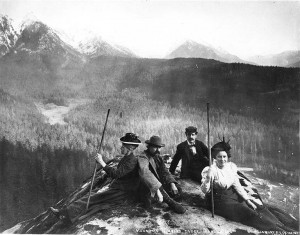 Two years after the Forest Service came into being, the Seattle branch of the Mazamas split off and became The Mountaineers, whose aims were “to explore the mountains, forests, and water courses of the Pacific NW…” They played a major role in the greater outdoor community.
Two years after the Forest Service came into being, the Seattle branch of the Mazamas split off and became The Mountaineers, whose aims were “to explore the mountains, forests, and water courses of the Pacific NW…” They played a major role in the greater outdoor community.
Not Held Back by Petticoats
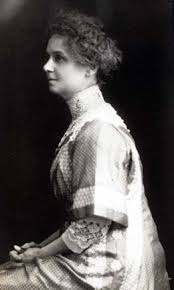 From the 1890s on, women hiked and climbed in the Pacific NW. Though bound by fashion that corseted and skirted them on the main street, they were ingenious in getting around a few rules. In some instances, they wore bloomers but many times they went in their skirts, with knickerbockers underneath. Or just wool pants. In 1909, when a number of women climbed Mount Rainier during a suffragette convention in Seattle, group leader Cora Smith Eaton compiled a list of what to bring:
From the 1890s on, women hiked and climbed in the Pacific NW. Though bound by fashion that corseted and skirted them on the main street, they were ingenious in getting around a few rules. In some instances, they wore bloomers but many times they went in their skirts, with knickerbockers underneath. Or just wool pants. In 1909, when a number of women climbed Mount Rainier during a suffragette convention in Seattle, group leader Cora Smith Eaton compiled a list of what to bring:
1. Sleeping Bag, consisting of three bags, one inside the other.
- Waterproof shell, of kahki (sic) or rubber or parafined (sic) canvas or oiled silk.
- Double wool blanket bag.
- Comfort padded with wool bats, the comfort folded and sewed together as a bag.
2. Tramping suit:
- Bloomers or knickerbockers.
- Short skirt, knee length, discarded on the hard climbs.
- Wool wait or jumper.
- Sweater or heavy coat.
3. Three pairs of cotton hose.
4. Three pairs of boys’ wool socks to wear as the second pair of hose to prevent chafing.
5. Mountain boots to the knee, with heavy soles, heavy enough for hob-nails, and these must be placed in soles before starting, using 3 1/2 eighths Hungarian nails in the instep as well as the heels and soles.
6. Lighter shoes, like tennis shoes, for camp.
7. Gaiters to wear with the light shoes.
8. Chamois heel protectors, worn next to the skin, or adhesive plaster, to prevent blistering the heel.
9. Two winter undersuits, ankle length and long sleeves.
10. Two lighter undersuits, ankle length and long sleeves.
11. One dark colored night robe or pajamas.
12. Hat, lightweight, with medium brim.
13. Mosquito head net or bee veil.
14. Smoked goggles.
15. Heavy gauntlet gloves.
16. Three bandana handkerchiefs.
17. Rubber poncho, or slicker coat.
The climb was successful. On the summit, the group placed a flag with the AYP (Alaska-Yukon-Pacific fair) symbol with a Votes for Women banner underneath.
No Slouches at Home
Many of the women who climbed came from the middle class. Wives of UW faculty or professors themselves, local enthusiasts from logging communities around the mountains, or business owners. Dr. Cora Smith Eaton was one such woman. The first woman to practice medicine in ND, she came to the northwest for a suffragette convention in 1907. She climbed Mount Hood and later moved to Seattle. She was one of the co-founders of the Mountaineers. Another, Mary Davenport Engberg, ran a pharmacy in Bellingham, WA with her husband. She was an active outdoorswoman who made numerous expeditions to Mount Baker, naming a number of its features, including Bastille and No Name Glaciers. She was also an accomplished violinist and conductor. She started a 65-piece orchestra.
*****
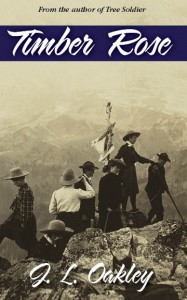 A big thanks to Janet Oakley. She’ll give away a trade paperback copy of Timber Rose to someone who contributes a comment on my blog this week. I’ll choose the winner from among those who comment by Friday at 6 p.m. ET. Delivery is available within the U.S. only.
A big thanks to Janet Oakley. She’ll give away a trade paperback copy of Timber Rose to someone who contributes a comment on my blog this week. I’ll choose the winner from among those who comment by Friday at 6 p.m. ET. Delivery is available within the U.S. only.
**********
Did you like what you read? Learn about downloads, discounts, and special offers from Relevant History authors and Suzanne Adair. Subscribe to Suzanne’s free newsletter.
